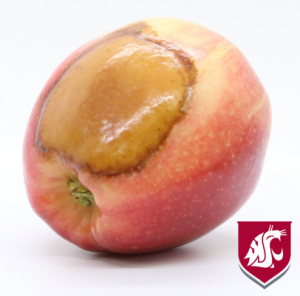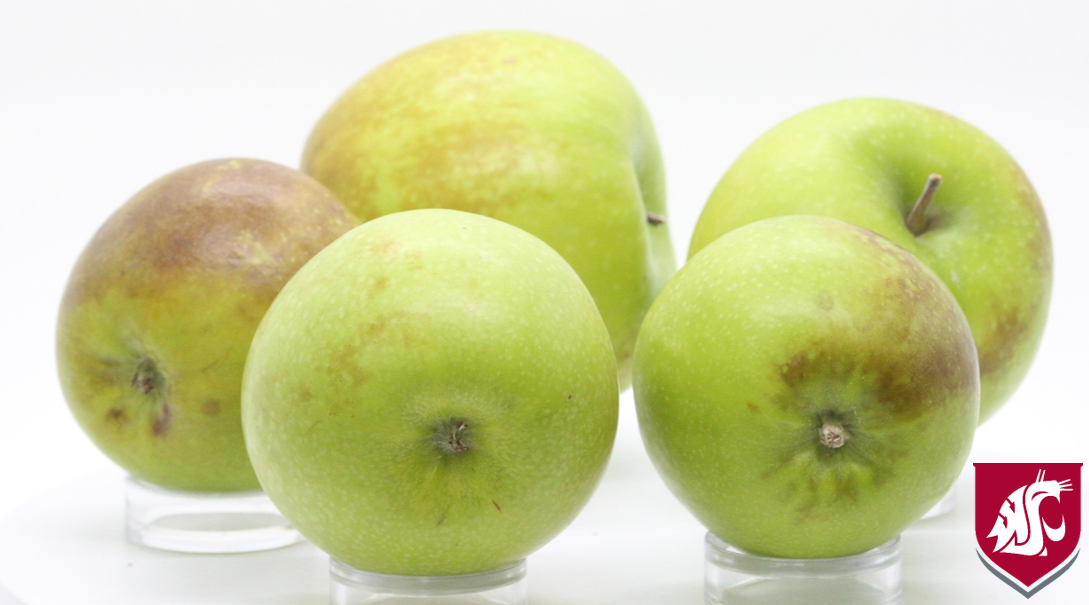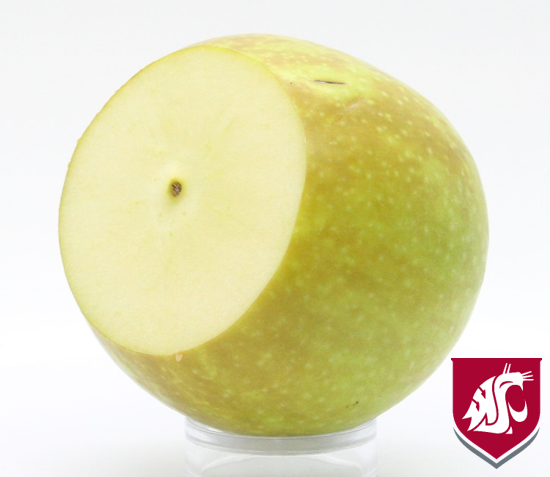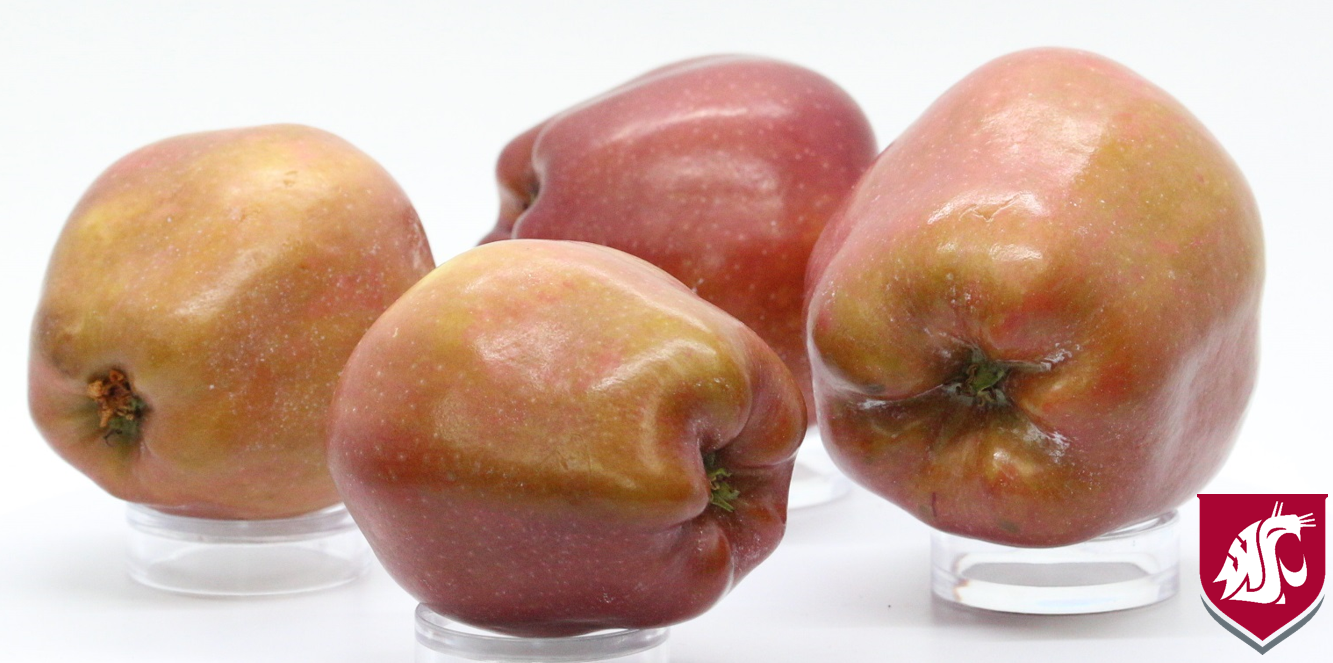by Rob Blakey, WSU Extension Specialist, Post Harvest
Superficial scald, also called storage scald, is a pre-eminent physiological disorder caused by chilling injury. This article is a brief overview and update on scald management. Symptoms in Granny Smith and Red Delicious are below. Superficial scald symptoms are:
- Diffuse i.e. no defined edges between affected and unaffected skin,
- Irregular,
- Restricted to the skin, and
- Light brown to dark brown to black in color.
Symptoms most often appear on the shaded side of fruit, and are accelerated with removal from cold storage. Variants can include rugose scald and lenticel scald (Meigh 1970, Wilkinson and Fidler, 1973).
These photographs are part of a collaborative project between WSU Extension, the Washington Tree Fruit Research Commission, and the Good Fruit Grower where we are making a new apple defect guide.
Photograph 1: Symptoms of superficial scald in Granny Smith (top 2)) and Red Delicious (bottom). Photo credits TJ Mullinix, Good Fruit Grower.
Physiology of Superficial Scald
The skin browning seen in superficial scald is caused by the oxidation of α-farnesene, a volatile compound naturally produced by the apple. This compound accumulates in the wax layer during the first 8-12 weeks of cold storage (Lurie and Watkins, 2012). The concentration of α-farnesene as the fruit ripens, tracking ethylene production. It is oxidized by atmospheric oxygen.
Risk Factors
1. Fruit Maturity & Cultivar
Scald is increased when fruit are harvested when physiologically immature (Wang and Dilley, 1999). These are typically (i) highly colored strains, which can and are picked earlier, (ii) Granny Smith, which is picked while immature to maintain green color, and (iii) fruit for long term storage, which are picked immature or marginally mature. Fruit with starch values less than 3 on 0-6 starch clearing index have a higher risk of developing superficial scald.
Table 1: Superficial scald risk for major apple cultivars in Washington, adapted from Kupferman (2001) and Lurie and Watkins (2012).
| Cultivar | Risk |
| Cosmic Crisp™ | Low |
| Fuji | Moderate* |
| Gala | Low |
| Golden Delicious | Low |
| Granny Smith | High |
| Honeycrisp | Low |
| Pink Lady | Low |
| Red Delicious | Moderate* |
*Can be High in early pick strains
2. Orchard Temperature
Fruit from orchards that have had less than 150 cumulative hours below 50°F (10°C) have a higher risk of developing superficial scald – see the Decision Aid section below. Temperatures above 77°F (25°C) during the month prior to harvest increase the risk of fruit developing scald (Kupferman, 2001).
3. Nutrient Content & Fruit Size
Fruit with high potassium, high nitrogen, and low calcium have a greater risk of developing scald (and bitter pit). Larger fruit have a higher risk of developing scald.
4. Climate and Moisture
Fruit grown in warmer and drier climates (like Washington) having a higher risk of developing scald than those grown in cooler climates. Fruit from orchards with low moisture content have a higher risk of developing scald.
Management
This brief overview is not meant to be comprehensive, for more information, please refer to Lurie and Watkins (2012).

1. Anti-oxidants
Diphenylamine (DPA) is widely used to control scald. DPA prevents the accumulation of the α-farnesene oxidation products (i.e. conjugated trienols). DPA effectiveness can be reduced if the treatment is delayed (Rudell et al., 2009). Always consult your DPA supplier for the latest recommendations. DPA can result in chemical burn with prolonged exposure (Photograph 2).
Finding a viable alternative anti-oxidant to DPA for apples, and ethoxyquin for pears, has proven challenging. Lipid-soluble anti-oxidants, particularly α-tocopherol, have not been effective, and can even increase oxidation while water-soluble anti-oxidants have not been effective in reducing scald development (Lurie and Watkins, 2012).
2. Ethylene Management
Ethylene scrubbing or removal can reduce scald by reducing the synthesis of α-farnesene and the therefore accumulation of its oxidation products, but maintaining ethylene levels at sufficiently low levels is difficult commercially. A more effective strategy is to make use of anti-ethylene compounds. In addition to maturity management, AVG inhibits internal ethylene production and α-farnesene production, reducing the risk of scald development (Mir et al., 1999). MCP is very effective in decreasing the accumulation of α-farnesene in apple fruit by indirectly inhibiting its synthesis via its effect on ethylene reception and synthesis.
3. Ventilation
Increasing ventilation rates, in air- and CA storage, can reduce scald incidence, but less so in high-risk years. Associated with this, lower relative humidity can increase the evaporation of volatiles (including α-farnesene and ethylene) and reduce scald development. Conversely, poor ventilation (as in some polyethylene bags) can increase the risk of scald development.
4. Ultra Low Oxygen Storage
Ultra-low oxygen storage (ULOS) is effective in reducing the oxidation of α-farnesene by severely restricting the oxygen in the storage atmosphere. Oxygen concentrations are about 0.7%, and close to the anaerobic compensation point. The risk of ULOS is anaerobic conditions and fermentation – and significant losses – but with modern storage technology, this is reduced. The lack of scald mitigating treatments for organic fruit leaves ULOS as the primary method for scald control.
5. Other Strategies
As scald is a major disorder in apples, there have been many attempts at its mitigation. Two technologies that could have potential are initial low oxygen stress and postharvest UV light.
Initial low oxygen stress (0.25% – 0.5%) for 2 weeks, followed by ultra-low oxygen storage, has been effective in reducing scald (Wang and Dilley, 2000; Zanella, 2003), but does risk fruit damage.
Postharvest UV light reduced scald development (Rudell and Mattheis, 2009). This may be promising for post-packing scald and pathogen control if the application time can be shortened to be compatible with packing line speeds.
6. Decision Aid Tools
Dave Rudell (USDA-ARS Wenatchee) and Rob Blakey are working on a WSU Factsheet titled “Superficial Scald Risk Assessment Assay for Apples” outlining a warehouse-suitable method to quantify the oxidation products of α-farnesene using a spectrophotometer. The assay can be used to rank storage rooms according to the risk of developing scald, so corrective actions can be taken on high-risk rooms. This publication will be available in the coming weeks on the WSU Tree Fruit website.
WSU DAS (www.decisionaid.systems) has a model for superficial scald, using the cumulative hours below 50°F (10°C). Scald potential is higher, and scald prevention is required for stored fruit, when less than 150 hours below 50°F have accumulated, and starch content is less than 3 (on the 0 to 6 scale used in Washington). At starch levels higher than 3, fruit maturity predominates the cooling requirement. For example, in 2016, the threshold was reached in the first three weeks of October (Table 1).
Table 2: Date in 2016 to reach more than 150 cumulative hours below 50°F (10°C) at five WSU DAS weather station locations throughout Washington.
| Location | Date to reach threshold |
| Brewster | October 13 |
| Wenatchee (WSU TFREC) | October 11 |
| Mattawa | October 20 |
| Pomona | October 5 |
| Roza (WSU IAREC farm) | October 15 |
Conclusion
Growers and warehouses have a number of tools available to manage scald (i.e. DPA, AVG, MCP, and storage technologies), and decision aid tools – like the biomarker assay and similar emerging technologies – to provide timely information about the effectiveness (or not) of these treatments, so corrective actions can be taken to reduce crop and financial losses from scald damage.
Literature Cited
Kupferman, E., 2001. Storage Scald in Apples [WWW Document]. URL http://postharvest.tfrec.wsu.edu/EMK2000C.pdf (accessed 7.18.17).
Lurie, S., Watkins, C.B., 2012. Superficial scald, its etiology and control. Postharvest Biol. Technol. 65, 44–60. doi:10.1016/j.postharvbio.2011.11.001
Mir, N.A., Perez, R., Schwallier, P., Beaudry, R., 1999. Relationship between Ethylene Response Manipulation and Volatile Production in Jonagold Variety Apples. J. Agric. Food Chem. 47, 2653–2659. doi:10.1021/jf981150k
Rudell, D.R., Mattheis, J.P., 2009. Superficial scald development and related metabolism is modified by postharvest light irradiation. Postharvest Biol. Technol. 51, 174–182. doi:10.1016/j.postharvbio.2008.07.008
Rudell, D.R., Mattheis, J.P., Hertog, M.L.A.T.M., 2009. Metabolomic Change Precedes Apple Superficial Scald Symptoms. J. Agric. Food Chem. 57, 8459–8466. doi:10.1021/jf901571g
Wang, Z., Dilley, D.R., 2000. Initial low oxygen stress controls superficial scald of apples. Postharvest Biol. Technol. 18, 201–213. doi:10.1016/S0925-5214(00)00067-3
Wang, Z., Dilley, D.R., 1999. Control of superficial scald of apples by low-oxygen atmospheres. HortScience 34, 1145–1151.
Zanella, A., 2003. Control of apple superficial scald and ripening—a comparison between 1-methylcyclopropene and diphenylamine postharvest treatments, initial low oxygen stress and ultra low oxygen storage. Postharvest Biol. Technol. 27, 69–78. doi:10.1016/S0925-5214(02)00187-4
Contact
Tree Fruit Extension Specialist, WSU Extension
Postharvest Information & Technology Transfer
509-786-9284
rob.blakey@wsu.edu



